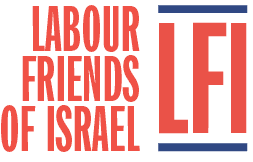The green and yellow flags, adorned with an upturned machine gun, which were on display on the streets of central London last weekend were those of the anti-Semitic terror group, Hezbollah.
The flags have become a regular feature of the annual Al Quds Day parade through the city, but, given the origins of the event, an entirely appropriate one. Al Quds Day is the annual day chosen by the late Ayatollah Khomeini to call for the destruction of Israel. Indeed, this – not the rights of the Palestinians – is its primary purpose. As the former Iranian president, Mahmoud Ahmadinejad, put it: “The Quds Day is not merely a strategic solution for the Palestinian problem … any freedom lover and justice seeker in the world must do its best for the annihilation of the Zionist regime.”
Last year, Hezbollah flags were carried and waved by participants, along with words bearing the placards: “We Are All Hezbollah”. This year, Hezbollah flags were, once again, prominent. This is unacceptable. It exploits a distinction between Hezbollah’s ‘military’ and ‘political’ wings which the organisation itself does not recognise and disguises the group’s very nature.
Hezbollah emerged during the Lebanese civil war in the 1980s. Iranian-backed, it seeks to establish a Shiite Islamic state that encompasses both Lebanon and Israel. It has been implicated in a string of deadly terrorist attacks stretching back three decades against Israeli, Jewish and western targets both in the Middle East and far beyond. In 1983, for instance, Hezbollah was responsible for the murder of 241 American marines at the multinational force barracks in Beirut. In March 1992 a Hezbollah suicide bombing at the Israeli Embassy in Buenos Aires killed 29 people. Two years later, Hezbollah affiliates bombed the Argentine Jewish Mutual Association building in Buenos Aires, murdering 85 people. In July 2012, Hezbollah operatives attacked a bus of Israeli tourists in the Bulgarian resort of Burgas, killing 12. In 2010, the Obama administration labelled Hezbollah “the most technically capable terrorist group in the world”, suggesting three years later that its terrorist activity had reached “a tempo unseen since the 1990s”.
Israel is, of course, Hezbollah’s principal target. In July 2006, it provoked a war with the Jewish state – which had unilaterally withdrawn from its southern Lebanon “buffer zone” six years previously – by kidnapping two IDF soldiers who were part of a patrol on the border between the two countries. It then proceeded to launch katyusha rockets to indiscriminately pound northern Israel. The ensuing Second Lebanon War led to the creation of a UN force – UNFIL – which was supposed not only to prevent skirmishes between Israeli and Hezbollah soldiers, but also to stamp out arms smuggling from Syria into strongholds in Lebanon controlled by the terror group.
Sadly, UNFIL proved unwilling or unable to perform this latter task. Israel now estimates that Hezbollah has 100,000-120,000 rockets hidden among the civilian population of southern Lebanon. Its paymasters in the Iranian Revolutionary Guard boasted earlier this year that they had established underground rocket factories in Lebanon which are under the full control of Hezbollah. In February 2016, Hezbollah General Secretary Hassan Nasrallah threatened to attack Israel’s ammonia factory in Haifa, warning that the damage caused would be the equivalent of a nuclear bomb.
Hezbollah has not simply exported terror globally and wreaked havoc in Israel and Lebanon, it has also – again at Iran’s behest – sent forces to fight for President Assad’s murderous regime in Syria. Last year it was estimated that one-quarter of Hezbollah’s forces – some 5,000 men – were engaged in fighting in Syria. In addition to support from Iran, Hezbollah funds its activities by both informal networks and centrally run enterprises described recently by one analyst as operating like “international organised criminal entities”. It is heavily involved in money laundering, arms sales and drugs smuggling.
Like Hamas, Hezbollah is guided by a deeply anti-Semitic mission, Nasrallah having previously declared: “If all Jews gather in Israel, it will save us the trouble of going after them worldwide”.
The UK government has long held the view that Hezbollah’s military wing has been involved in conducting and supporting terrorism. In March 2001, the Hezbollah External Security Organisation was added to the list of proscribed organisations under the Terrorism Act 2000. In 2008, the then Labour government proscribed the entire Hamas military wing. In 2013, the European Union did likewise.
Other countries, however, have taken a tougher stance, proscribing both Hezbollah’s military and political wings. The Clinton administration named Hezbollah a terror entity in 1995. Canada, the Netherlands, the Arab League and the Gulf Cooperation Council have adopted the same approach. The reason is simple. The distinction between Hezbollah’s military and political wings is a dangerous game of semantics, one which the terror group itself does not play. Its Deputy Secretary General, Naim Qassem, stated in 2009 that the “same leadership that directs the parliamentary and government work also leads jihad actions in the struggle against Israel”. In 2012, he further stated: “We don’t have a military wing and a political one; we don’t have Hezbollah on one hand and the resistance party on the other.” He continued: “Every element of Hezbollah, from commanders to members as well as our various capabilities, are in the service of the resistance and we have nothing but the resistance as a priority.”
However, the fact that the UK does not proscribe its political wing enabled marchers to claim that it was this – and not the terrorists’ military wing – that they were supporting; an argument which apparently held sway with the police. It’s now time to end this game of semantics, proscribe Hezbollah in its entirety and thereby recognise its true character.
